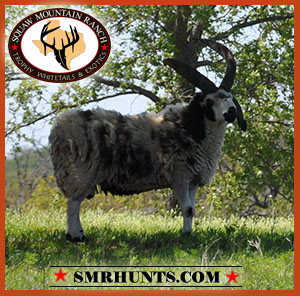
When you hear the name four-horn sheep, you may also hear these sheep being referred to as Jacob Sheep. While their exact origins remain a mystery, some speculate they came from Syria nearly three-thousand years ago. The name “Jacob” is derived from the Biblical figure that is thought to have bred this particular type of sheep. The Four-Horn or Jacob Sheep gets its name from its appearance. The multiple horns make them stand out and are the primary reason why they are attractive to hunters for trophy hunts. Two horns can be seen curving along the side of their head, with two on the top of the head. Some four horn sheep have horns as long as 30 inches! Other Jacob sheep can have as many as six horns. Understanding four horn sheep mating behavior, habitat, and eating behavior can make for a more successful hunt.
Four Horn Sheep Mating Behavior
Four Horn Sheep are seasonal breeders. Typically they cycle during the cooler autumn months, beginning the first autumn after they’re born. Rams and ewes are known to only come together for mating. During this time, the rams are known to fight. During this mating period, often referred to as the “rut”, males will push and shove one another. The males will typically back away before getting up on their hind legs and lunging forward. These battles will continue until one of the rams gives in.
Typically only the stronger and older rams with the bigger horns are able to mate. After mating occurs, an ewe will remain pregnant for about 174 days.
Lambs are born during the spring time, usually on high, secluded ledges to protect them from predators like wolves, coyotes, and mountain lions. When the ewes do give birth they will only have one lamb at a time. But, multiple births of twins and even triplets are not uncommon in subsequent births.
Four Horn Sheep are instinctively good mothers, taking excellent care of their offspring. Lambs can walk soon after birth, but will stay with their mothers for a few weeks. While many may begin weaning at the two-month mark, many shepherds won’t separate the lambs from their mothers until the four-month mark, allowing them to nurse for longer.
More Info on Four Horn Sheep Mating Behavior
While the lambs may go off with other lambs, they will return to feed. Once weaning takes place the females often remain in the herd with their mothers while the males leave anywhere from the time they are 2-4 years old to join a herd of rams. When they go off, the older rams teach the younger rams how to survive in the different habits.
Females will usually mate and produce offspring around 18 months while the males will not usually breed until they are at least three years old.
Four Horn Sheep are one of the preferred breed of sheep by shepherds because of their easy lambing and excellent mothering capabilities. Right at birth, the offspring show the multi-horned characteristic that they are famous for. Typically the four horn sheep will live for around nine years with some males rarely living 12 years and females rarely living 15 years.
At Squaw Mountain Ranch there is a great herd of Four Horn Sheep. We track Four Horn Sheep mating behavior to keep track of the growing population. Since there are no seasonal restrictions on hunting Four Horn Sheep in Texas, it is a year-round activity that hunters can take part in.
A team of highly trained staff at Squaw Mountain Ranch provides hunting guides that will give insight and advice as to the best methods and techniques. Squaw Mountain Ranch can also accommodate those with disabilities. A fair chase hunt is ensured each and every time as well as a trophy any hunter will be proud to display.
Squaw Mountain offers different trophy hunting packages and price ranges to suit every hunter’s needs.
